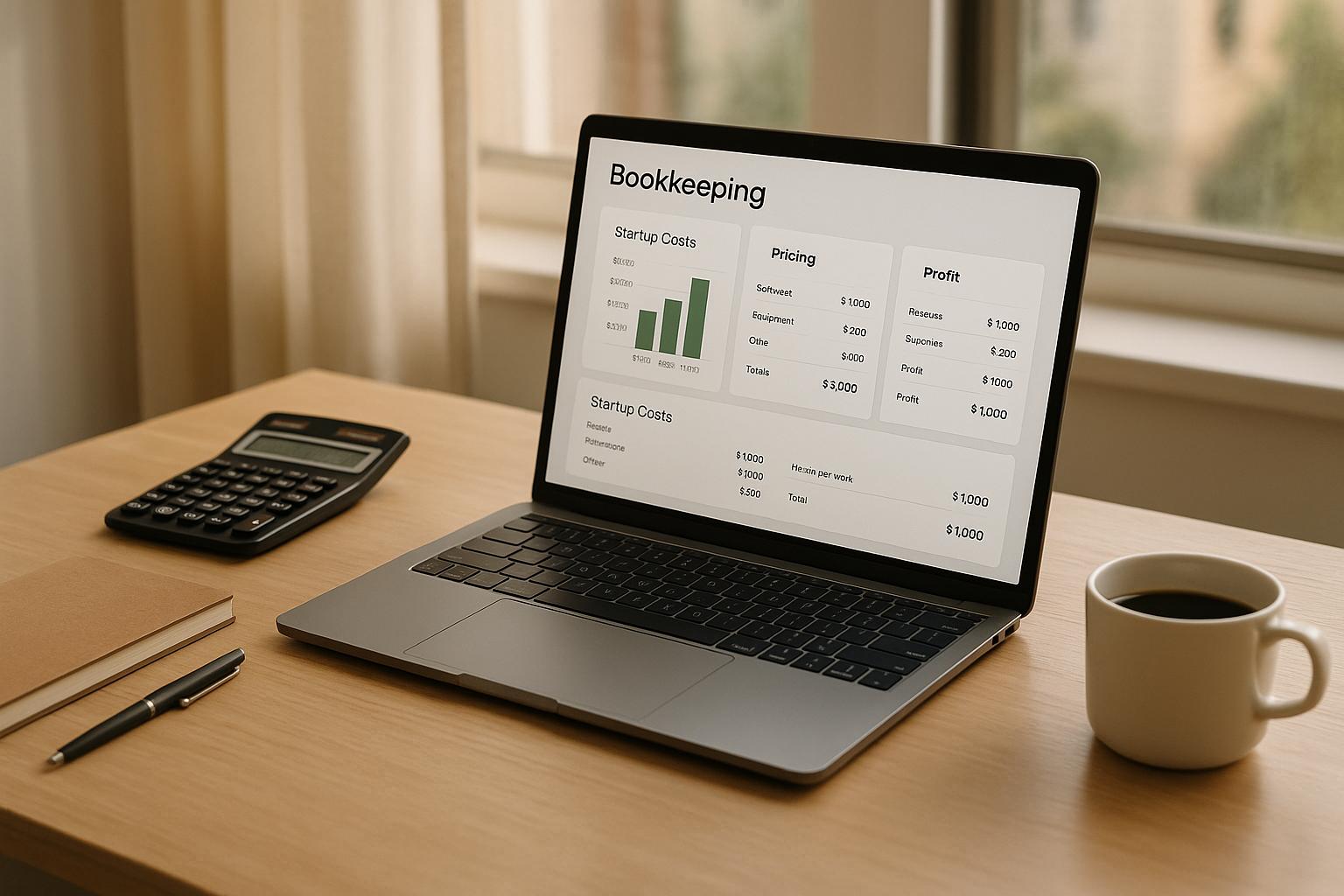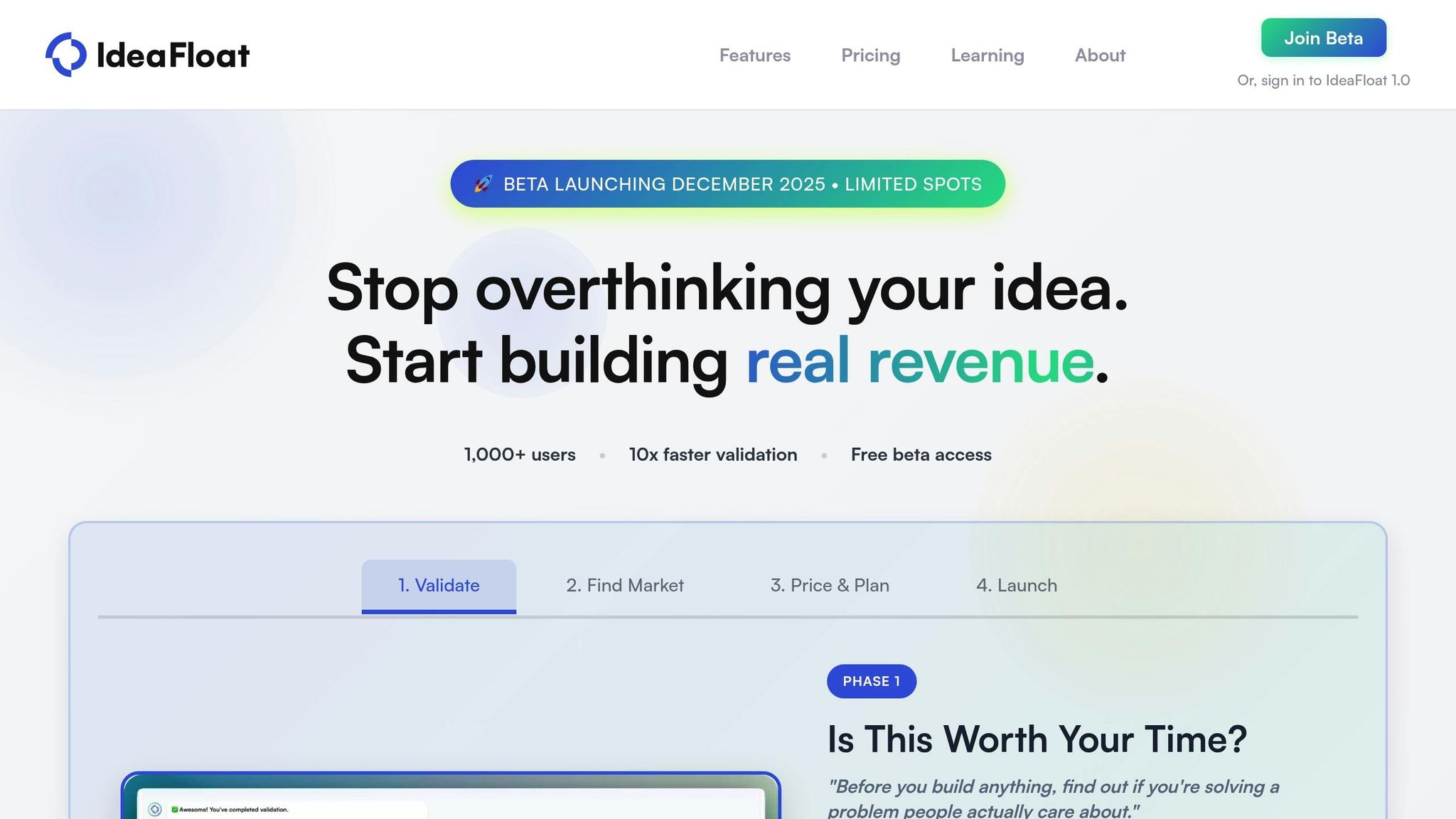
Starting a bookkeeping business can be affordable, but understanding your costs upfront is essential to avoid financial surprises. Here's what you need to know:
- Startup Costs: Expect to spend $150 to $1,500 depending on your setup, including equipment, internet, and security tools.
- Software Options: Popular choices like QuickBooks Online, Xero, FreshBooks, and Wave vary in pricing and features. Choose software that suits your business size and client needs.
- Service Pricing: Bookkeepers typically charge hourly rates ($43–$80) or monthly retainers ($250–$2,500), depending on service complexity and client industry.
- Profit Planning: Track expenses, calculate breakeven points, and monitor profit margins to ensure sustainable growth.
The right tools, pricing strategy, and financial planning are key to building a profitable bookkeeping business.
COST to start a bookkeeping business (cheap!)
Main Startup Costs for Bookkeeping Businesses
Starting a bookkeeping business comes with some upfront expenses, especially when it comes to technology and keeping client data secure. These investments are vital for ensuring smooth operations and safeguarding sensitive information.
Technology Requirements
To handle accounting tasks efficiently, you’ll need a dependable computer. Whether you choose a laptop or desktop, expect to spend around $800 to $1,500 for a business-grade machine. Pair that with a high-speed internet connection, which is crucial for cloud-based bookkeeping. Monthly internet costs typically range from $50 to $150.
Data Security Investments
Protecting client data is non-negotiable. A VPN service can help secure your online activities and costs about $5 to $15 per month. Add to that security software, which runs $50 to $200 per year, to guard against cyber threats. For safe data backups, consider encrypted external storage drives, which usually cost between $100 and $300.
Next, we’ll take a closer look at bookkeeping software options and their associated costs, helping you plan your startup budget wisely.
Bookkeeping Software: Options and Pricing
After investing in technology and security, picking the right bookkeeping software is the next step toward efficient operations. This decision is more than just a practical choice - it shapes how you interact with clients, handle data, and grow your business. Below is a quick comparison of some popular bookkeeping software options to help you make an informed choice.
Popular Bookkeeping Software Comparison
The market offers a variety of bookkeeping tools, each with its own pricing and features. QuickBooks Online stands out with its flexible plans, catering to everyone from startups to businesses needing advanced tools like inventory tracking. Xero provides tiered pricing options tailored for growing businesses, with premium features such as multi-currency support and project tracking. If your focus is on invoicing and time management, FreshBooks is a strong contender, offering scalable pricing based on client volume. For those on a tight budget, Wave Accounting delivers a free basic bookkeeping solution, with optional paid add-ons for extras like payment processing.
| Software | Pricing Structure | Key Strengths | Ideal For |
|---|---|---|---|
| QuickBooks Online | Multiple tiers available | Extensive integrations and features | Full-service bookkeeping |
| Xero | Tiered pricing plans | Intuitive interface and strong reporting | Growing practices |
| FreshBooks | Scalable pricing options | Time tracking and invoicing capabilities | Service-focused bookkeepers |
| Wave | Free basic option + add-ons | Essential features at no cost | Very small startups |
These options vary in features and pricing, so it’s important to choose one that aligns with your business needs and budget.
How Software Choice Affects Your Costs
The cost of bookkeeping software goes beyond the subscription fee. Additional expenses, like integration fees or extended training, can add up quickly. Scalability is another key factor - while a free or basic plan might work initially, as your business grows, you may need to switch to a more robust platform. Migrating to a new system later can be time-consuming and costly.
It’s also worth considering your clients' preferences. Using software they’re familiar with can simplify onboarding and improve efficiency. On the security side, many platforms offer premium features such as two-factor authentication, advanced user permissions, and audit trails. These tools provide added protection for sensitive financial data, which is especially critical as your business handles more clients.
Ultimately, your software choice plays a big role in both your upfront costs and long-term profitability. It’s not just about saving money now - it’s about setting up a system that supports your business as it grows.
sbb-itb-08dd11e
How to Price Your Bookkeeping Services
Getting your pricing right is one of the most important steps to running a successful bookkeeping business. If your rates are too low, you may struggle to cover your expenses; price them too high, and potential clients might look elsewhere. The challenge lies in finding that sweet spot where your rates reflect the value you offer while staying competitive.
Common Pricing Models Explained
Hourly rates are a simple and common starting point, especially for new bookkeepers. According to the U.S. Bureau of Labor Statistics, the median pay for bookkeepers in 2024 was $23.66 per hour, or $49,210 annually. Freelance bookkeepers, however, tend to charge more. Data from Upwork shows freelancers averaging around $43 per hour, with experienced professionals charging anywhere between $43 and $80 per hour. Keep in mind, though, that hourly billing can sometimes work against you as you become more efficient - clients might question paying the same rate for less time spent.
Fixed-rate pricing (also called flat-fee or monthly retainer pricing) provides predictability for both you and your clients. Based on market research, average monthly bookkeeping costs generally fall into three tiers: basic services range from $250 to $350, mid-range services cost between $500 and $700, and premium packages start at $1,000 or more. For small to medium-sized businesses, outsourced bookkeeping typically runs between $500 and $2,500 per month. This model works well because it gives clients a clear, consistent monthly cost while helping you forecast your income.
Value-based pricing is growing in popularity, especially among seasoned bookkeepers. Instead of charging for the time spent, this model focuses on the value you bring to the client. For example, if your financial insights help a client save a significant amount of money, charging a higher fee makes sense. Many bookkeeping firms also use a tiered pricing structure within fixed-rate or value-based models, offering different service levels. These tiers might range from basic transaction recording to more advanced services like financial analysis and strategic advice.
Understanding these models is just the first step. Let’s look at the factors that influence your rates even further.
What Affects Your Pricing
Beyond the pricing model you choose, several other factors will shape your rates.
One of the biggest considerations is the scope of services you’re offering. Basic data entry is typically priced lower - around $300 per month - while more complex services like financial consulting and analysis can exceed $1,500 per month.
The industry your client operates in also matters. For example, retail businesses with high transaction volumes will require more work than service-based businesses with fewer transactions. Similarly, industries like construction, which involve job costing and project tracking, often justify higher fees.
Work complexity is another key factor. A simple business structure will cost less to manage compared to a multi-location company with inventory, payroll, and intricate tax needs. Additionally, geographic location plays a role. Bookkeepers in cities like New York or San Francisco can often charge 20% to 50% more than those in smaller towns or rural areas.
Lastly, your experience and credentials significantly impact your pricing. If you’re a QuickBooks ProAdvisor or have other certifications, you can command higher rates. The same goes for seasoned professionals with years of experience - clients are often willing to pay more for proven expertise.
How to Research and Set Your Prices
Pricing your services should align with your financial goals and business strategy. Start by researching local market rates. Check platforms like Indeed, LinkedIn, and freelance sites to see what other bookkeepers in your area are charging. Factor in your own expenses - such as software, insurance, marketing, and equipment - and calculate how many clients you can realistically manage to determine your profit margin.
When working with a new client, consider starting with an hourly rate to better understand the complexity of their needs. Once you have a clearer picture, you can shift to a value-based fee structure for ongoing services.
Make it a habit to periodically review your rates to ensure they keep up with market trends and your growing expertise.
Profit Calculations and Financial Planning
Once you've set your pricing, the next step is to translate those numbers into actual profit. Many new bookkeeping business owners tend to focus on revenue projections but sometimes overlook the importance of tracking expenses and calculating profit margins - both of which are crucial for long-term success.
Estimating Revenue and Profit Margins
To estimate revenue, start with realistic client goals and your chosen pricing structure. Monthly fees can provide a steady income stream once you’ve built a reliable client base. Keep in mind, though, that factors like client turnover and seasonal shifts in demand can influence your revenue.
Profit margins will depend on your business model and how efficiently you operate. For example, solo practitioners often enjoy higher margins since they avoid the costs associated with staff, such as salaries and benefits. On the other hand, businesses with employees need to account for these additional expenses. A straightforward way to assess profitability is to compare your total monthly revenue with your operating expenses. This gives you a clear picture of how much profit remains after covering costs.
When planning revenue, consider different scenarios. A conservative estimate might assume slow client growth in your first year, while an optimistic outlook could include referrals or seasonal services. As a solo practitioner, you’ll likely manage a limited number of clients, so calculate how many you’ll need to meet your annual revenue goal. This step is critical for setting realistic expectations.
Once you’ve estimated revenue, focus on tracking expenses to understand your actual profit potential.
Expense Tracking and Breakeven Analysis
Tracking expenses accurately is key to understanding profitability. Common monthly costs might include software subscriptions, professional insurance, marketing, and office supplies. Depending on your setup, these expenses can vary widely. Don’t forget to account for costs like continuing education, professional memberships, and even a portion of home office expenses if you’re working remotely.
To calculate your breakeven point, divide your total monthly expenses by the fee you charge per client. This will show you the minimum number of clients you need to cover your costs. It’s also wise to set aside a portion of your earnings for income and self-employment taxes.
Tools like IdeaFloat’s financial modeling features can help you track expenses, identify your breakeven point, and project growth. This kind of analysis is especially useful when considering major decisions, such as adjusting your rates or expanding your services.
With your breakeven point in hand, you can shift your focus to strategies for long-term growth.
Planning for Long-Term Profitability
Achieving sustained profitability means keeping a close eye on both revenue and expenses. Review your finances monthly and adjust your strategies quarterly to stay on track. This might involve raising rates for current clients, discontinuing services that don’t generate enough profit, or investing in automation tools to improve efficiency.
Recurring revenue streams can also support long-term profitability. Consider expanding into areas like payroll, tax preparation, or financial consulting. However, before adding new services, conduct a cost-benefit analysis to ensure they enhance your profit margins rather than just increasing your workload.
As your business grows, pay attention to client acquisition costs. Compare the expense of acquiring new clients to the recurring revenue they bring in to measure the success of your marketing efforts. Seasonal demand fluctuations are another factor to watch. For instance, demand may spike during tax season but slow down at other times. Building a financial cushion during busy periods can help you maintain cash flow during slower months.
Regular financial reviews are also an opportunity to evaluate your pricing. As you gain experience and expertise, it might be time to adjust your rates to reflect your growing value. This ensures your profitability doesn’t stagnate.
Finally, think about scaling your operations for the future. When you’re nearing full capacity, you’ll need to decide whether to increase prices, hire additional help, or invest in more efficient systems. These decisions will play a major role in your long-term success and sustainability.
Summary and Next Steps
Getting your bookkeeping business off the ground requires focusing on three core areas: startup costs, software selection, and pricing. These are the building blocks of your success and tie directly into the strategies we've covered earlier.
Key Points for Bookkeeping Entrepreneurs
- Calculate your startup costs. Factor in everything - software subscriptions, business registration, professional insurance, marketing, and ongoing education. Knowing your total investment is essential for planning.
- Pick software that grows with your business. Platforms like QuickBooks Online and Xero offer flexible pricing and features. Choose one that aligns with your clients’ needs and your service offerings, and don’t overlook the time-saving benefits of automation and integrations.
- Set pricing that works for you. Whether you opt for hourly rates, monthly retainers, or project-based fees, your pricing should cover costs and provide a healthy profit margin. Undervaluing your services can strain your business in the long run.
- Track expenses and analyze your breakeven point. This ensures financial stability and helps you make smart decisions about scaling, adjusting prices, or expanding services. Successful bookkeeping businesses aim for strong profit margins once they're fully operational.
With these essentials in place, let’s look at how IdeaFloat can simplify your planning process.
How IdeaFloat Can Help Your Business

Planning a business often involves weeks of research, but IdeaFloat’s AI-powered platform makes it easier and faster. It helps you validate your idea and refine your financial strategy right from the start, combining insights on costs, pricing, and planning into one seamless process.
- Market validation and pricing optimization. IdeaFloat analyzes competitive data to identify gaps in the market and applies proven pricing strategies. This eliminates guesswork and helps you find the perfect balance between attracting clients and maximizing profits.
- Accurate financial projections. The platform’s tools provide realistic revenue forecasts, track expenses, and calculate breakeven points. You can even test different growth scenarios to see how they impact your bottom line.
"IdeaFloat saved us weeks of work by helping us explore demand for new products across different regions and took the guesswork out of finding gaps in the market." - Nick Sherwing, Founder of woohoPets
- Professional business plans. IdeaFloat turns your research into polished business plans, complete with visuals and key financial data - ideal for investor pitches or loan applications.
With flexible pricing that includes a free tier, IdeaFloat is accessible to businesses of all sizes. Over 500 entrepreneurs have already used it to validate ideas and make data-driven decisions.
Starting a bookkeeping business doesn’t have to be overwhelming. With the right tools and a clear strategy, you can go from concept to profitability faster and with greater confidence.
FAQs
What should I consider when selecting bookkeeping software for my startup?
When picking bookkeeping software for your startup, it’s crucial to focus on what fits both your business needs and your budget. Let’s talk about cost first. Prices can range widely - from free options to several hundred dollars a month. For many startups, plans in the $150–$200 range often strike the right balance between affordability and functionality.
Next, take a close look at the features. Basic tools like invoicing, expense tracking, and financial reporting are must-haves. If your business demands more advanced capabilities - like integrations with inventory management systems or customer relationship management (CRM) platforms - be prepared for potentially higher costs. These extras can make operations smoother but may stretch your budget.
Finally, consider whether you prefer cloud-based software or on-premises solutions. Cloud-based options typically have lower upfront costs but come with ongoing subscription fees. On the other hand, on-premises software requires a bigger initial investment but avoids recurring charges.
By weighing these factors, you’ll be better equipped to choose software that fits your startup’s needs while keeping costs under control.
What’s the best way to price my bookkeeping services to stay profitable?
Choosing how to price your bookkeeping services is a critical step in ensuring your business stays profitable. Here are a few popular pricing methods to consider:
- Hourly Rates: Charge clients for the time you spend working. This method is straightforward but could cap your income as you become faster and more efficient at your job.
- Fixed Fees: Offer clients a flat rate for specific services or service bundles. This approach gives clients clarity on costs and provides you with consistent income. However, it may not account for unexpected challenges or extra work.
- Value-Based Pricing: Set your prices based on the benefits your services provide, like helping clients save money or gain better financial insights. While this can boost your earnings, it requires a deep understanding of your clients' needs and the outcomes they value.
To find the best pricing model for your business, think about factors like your level of expertise, the complexity of the services you offer, the industries you serve, and the competitive landscape in your area.
How can I track expenses and calculate profit margins for my bookkeeping business effectively?
To stay on top of your expenses, it’s crucial to separate your personal and business finances. Open a dedicated business bank account and use a business credit card for all transactions related to your work. Pair this with reliable accounting software to record and categorize every transaction from the start. This not only keeps your finances organized but also makes tax season far less stressful.
When figuring out your profit margins, consider key factors like your expertise, certifications, location, and the types of clients you work with. Select a pricing model that fits your business goals - whether it’s hourly rates, fixed fees, or value-based pricing. This approach helps ensure your business remains profitable and positioned for steady growth.
Related Blog Posts
Get the newest tips and tricks of starting your business!


